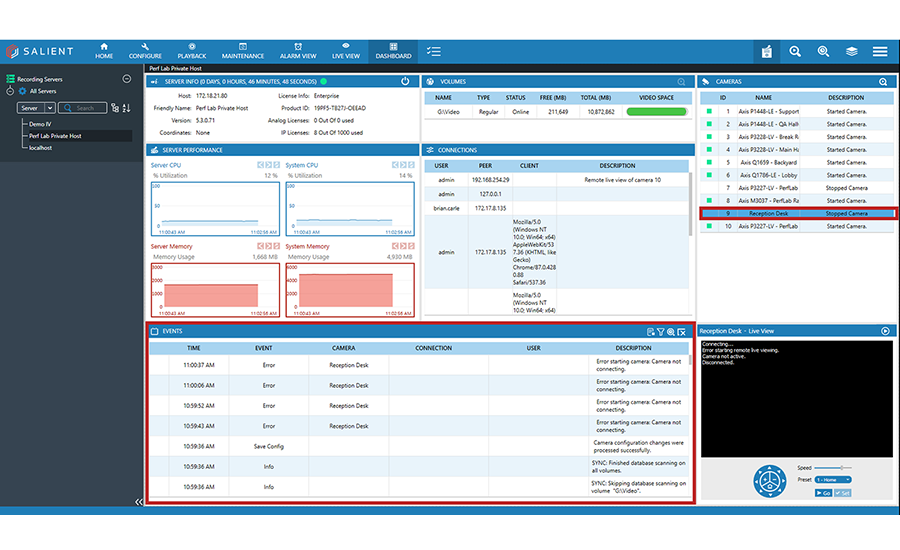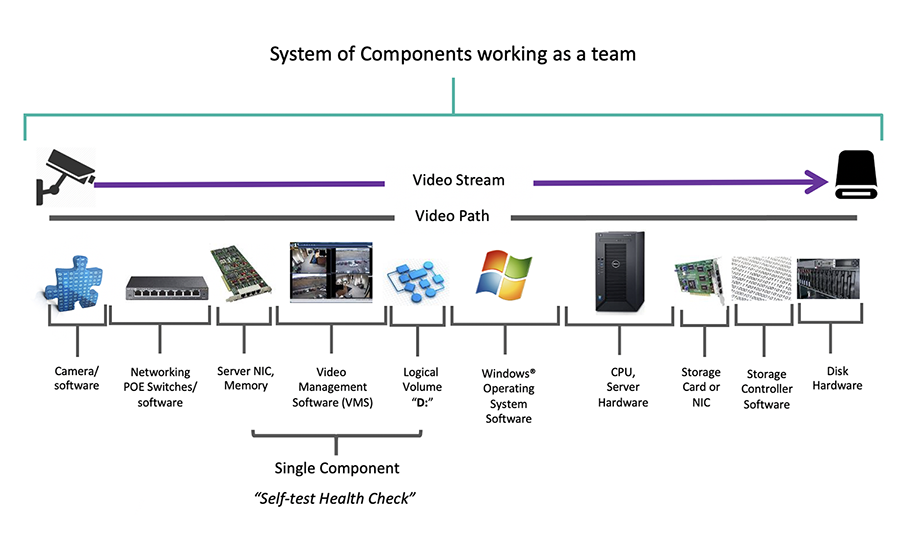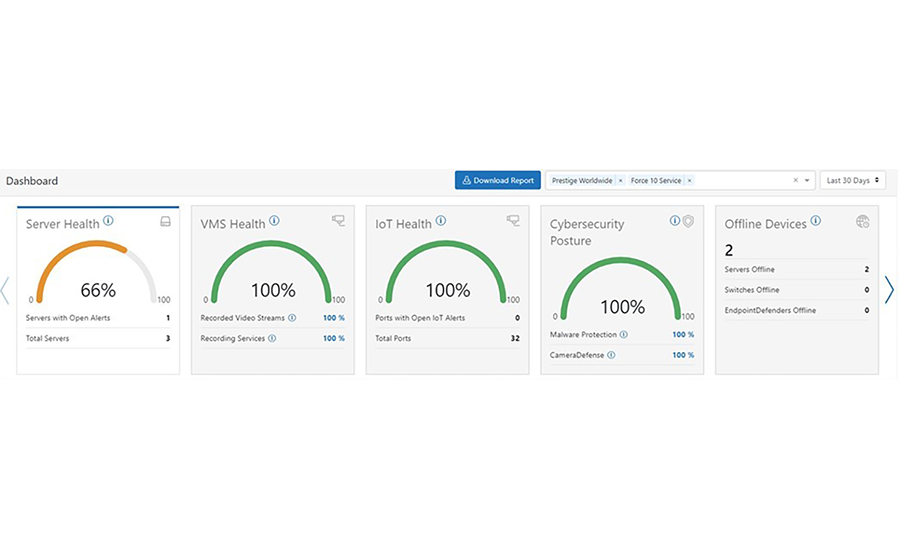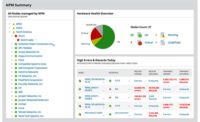Keeping video surveillance systems up and running can be challenging — in large part because not everything needed to keep the camera functioning properly is under the control of the security integrator. Video surveillance systems increasingly rely on local and wide area networks for connectivity and storage, and traditionally, neither the customer nor the integrator has had full visibility into the network.
Similar issues also exist for other networked security equipment such as access control.
Fortunately, the security industry has developed a relatively new category of technology, sometimes referred to as network health monitoring, which is aimed at detecting and addressing network-related problems. In addition to providing a better end-user experience, the technology also may provide recurring monthly revenue.
In this article, we look at network health monitoring options and what dealers should think about as they consider implementing the technology.
Video Management Systems
Video management system (VMS) manufacturers have been adding more and more diagnostic and alert capabilities to their offerings. For example, Austin, Texas-based Salient Systems has put capabilities into its VMS aimed at preventing customers from viewing more simultaneous video streams than the network connection can support.
As Salient Chief Product Officer Sanjay Challa explains, the company also is working on adding a predictive capability that will advise integrators and their customers about the maximum number of cameras than a network connection can support. The goal is for the VMS to determine the recording resolution that a customer can expect based on how many cameras are added.
Salient equipment also has traditional VMS capabilities that send alerts to the customer and/or the integrator when a camera is not working. Thresholds can be set to avoid overwhelming recipients with too many alerts, Challa explains. For example, the equipment could be set up so that there is no notification if synchronization loss is detected but the system regains synchronization within one minute. In that situation, however, the synch loss event would be logged for future reference.
VMS alerts typically are sent to designated parties via email or text based on an end user’s preference. Alternatively, or in addition, integrators may want to offer customers the option of having signals go to the central station or to have the integrator address the reported problems. Security integrators can earn recurring monthly revenue by charging the customer for this service on a monthly basis or they can build it into a service and maintenance plan.
Salient and some other VMS manufacturers have integrated their systems with central station automation software from various vendors. Integrators also may opt to do their own integrations. Challa says Salient has application programming interfaces (APIs) that make it easy to integrate with the central station.
The company also has integrated with some video analytic systems, which can enable some additional network health diagnostics, such as an alert if a camera is bumped and no longer aimed as intended.
There are limits on the network health monitoring capabilities that a VMS alone can provide, however. “Where we see it get tricky quickly is on the network side, especially on very large deployments — the VMS isn’t in charge of the network,” Challa says.
Network Health Monitoring Sales Tips
Paul Slaman, regional director-sales solutions for Santa Ana, Calif.-based security integrator Allied Universal references a big news story of 2016 to illustrate the need for network health monitoring.
That was the year that a sniper shot several policemen in Dallas. When subsequent investigators sought video footage from businesses in the area that had surveillance cameras, about 28 percent of the cameras were not recording. And that’s not unusual.
According to Viakoo, it’s also not unusual for a camera to go a week or more without recording before someone notices the issue.
With numbers like these in mind, several sources interviewed for this story advise integrators to pitch network health monitoring for every video job. They also see a strong retrofit market and opportunities to monitor the health of other networked equipment as well.
“Ask about things beyond security and CCTV,” advises Brad Wilson, president of San Jose, Calif.-based integrator RFI Communications and Security Systems. Wilson points to opportunities to monitor air filtration systems, for example.
Be careful not to oversell, though, Wilson cautions.
“People tend to hear what they want to hear,” he says. Accordingly, it’s important for the dealer or integrator to be clear on what the technology can and can’t do.
Rochester, N.Y.-based systems integrator Securitronics recently began offering network health monitoring and, according to Securitronics President Terry Rivet, the company already has seen positive results from the company’s first customer for the offering — a business with sites nationwide.
Securitronics rolled the cost of the Viakoo network health monitoring service into its service contract with the customer. Alerts are sent to Securitronics so that the company can quickly address problems. In one case, the company had to replace a camera in a distant city and was able to immediately dispatch a subcontractor and advise the subcontractor of the make and model of the camera that needed replacing.
Network Health Monitoring
Network health monitoring originated in the information technology (IT) world as a means of alerting IT personnel to network problems. But according to Tom Galvin, chief product officer for Dallas-based Razberi Technologies, those tools can be difficult to set up and manage.
Razberi offers what Galvin calls an IT tool built for physical security, which consists of software that runs on a Razberi or third-party server that monitors servers and video recorders as well as VMSs and other equipment. The software detects and reports issues such as storage and hardware problems.
According to Galvin, the offering lets dealers diagnose problems before rolling a truck, thereby lowering maintenance costs. The offering also has an interface to Solarwinds, the network health monitoring software that is used by many IT departments.
“[Often], IT wants visibility,” Galvin notes.
Integrators pay for the Razberi physical security network health monitoring service on a monthly basis. Razberi is in the process of enabling its offering to do software updates, reboot cameras and manage access control systems.
Providers of central station automation software also are getting involved with network health monitoring. For example, Colorado Springs, Colo.-based Bold Group offers a device that integrators install at a customer’s location to monitor network health.
As Bill Brousseau, director of technology for Bold, explains, the device uses standard IT protocols such as SNMP (simple network management protocol) to monitor cameras, access control equipment and other devices at the customer premises.
“As long as it’s an IP device, it can be monitored,” Brousseau observes.
The device is designed to communicate with a network operations center run by Bold or with the central station. In either case, operators can respond to various types of alerts as requested by the customer.
Digital Twin Technology
Another company that offers network health monitoring technology designed specifically for the physical security industry is Mountain View, Calif.-based Viakoo, which provides software that runs on an application server on the customer network.
According to Viakoo Vice President of Marketing John Gallagher, the software gathers information from devices on the network at regular intervals. Information is highly detailed and includes metrics such as motherboard temperature, memory utilization in cameras, storage capacity, bad sectors in storage, and more.
The information is used to create a “digital twin” that is analyzed to get to the root cause of problems. For example, if a PoE switch fails, taking 24 cameras offline, the system reports the switch failure, rather than 24 separate camera failures. The software also has some edge processing capability, enabling the most important alerts to be detected most quickly.
Integrators pay for the service on a per-device, per-month basis, Gallagher explains. They can also opt for a blended service in which Viakoo sorts out how problems should be addressed and integrates with the integrator’s service team or customer’s in-house security team to make the fixes happen.
The Viakoo offering also can manage firmware updates for devices on the network and according to Gallagher, some end users purchase the offering just for that capability — initially, at least.
Considering that network health monitoring not only helps reduce an integrator’s costs, but also can generate new revenues, these and other similar offerings would seem to be something that any company that offers video or other networked systems should explore.






